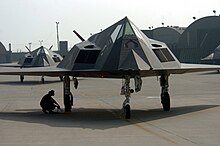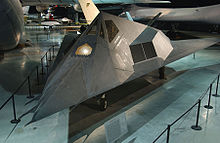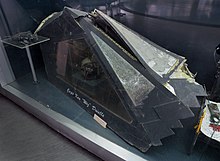Lockheed F-117
| Lockheed Martin F-117 Nighthawk | |
|---|---|
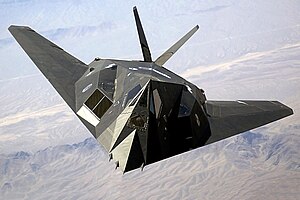 Front view |
|
| Type: | Stealth plane , tactical bomber |
| Design country: | |
| Manufacturer: | |
| First flight: |
June 18, 1981 |
| Commissioning: |
October 1983 |
| Production time: |
1982-1990 |
| Number of pieces: |
64 |
The F-117A Nighthawk is a twin -engine, single - seat aircraft that was developed by Lockheed for the US Air Force in the 1970s and manufactured with minor modifications until 1990. It was the world's first combat aircraft that successfully used stealth technology to avoid detectable waste heat and radar reflections. The F-117 was officially decommissioned in April 2008, but since then there have been reports of specimens still in flight. In February 2019, this was proven by photos of two machines during test flights.
history
Background and Lockheed Have Blue
The Lockheed Have Blue is a proof of concept for an aircraft with stealth technology that eventually led to the F-117A.
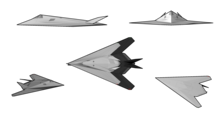
Senior Trend and F-117A
In 1978 the decision to buy the F-117 was made when a corresponding contract with the Skunk Works in Burbank was concluded (code name: Senior Trend ).
The first flight took place 31 months later, on June 18, 1981 by pilot Hal Farley from the Tonopah Test Range in Nevada. The first F-117A was delivered on August 23, 1982, the last in the summer of 1990.
The existence of the machine was only confirmed by the US Department of Defense on November 10, 1988.
The Air Force's only F-117 unit to date, the 4450th Tactical Group (now 49th Fighter Wing , Holloman Air Force Base , New Mexico), was operational from October 1983. The remarkably quick completion of the first series aircraft within just five years is mainly thanks to the Air Force's Aeronautical Systems Center at Wright-Patterson Air Force Base in Ohio , which made this possible thanks to an optimized test program and good cooperation with the manufacturer.
The first use of an F-117A took place on 19/20. December 1989, when six planes set off from Tonopah to bomb Panama ( Operation Just Cause ). On January 17, 1991, F-117A launched Operation Desert Storm against Iraq with attacks on Baghdad . In the Third Gulf War 40 F-117A were used and flew 1270 combat missions. On March 20, 2003, they launched Operation Iraqi Freedom .
In 1998, the unit cost of an F-117 was around $ 80 million, according to the USAF.
At the end of October 2006, the US Air Force confirmed that the F-117A would be decommissioned within the next few years and replaced by the F-22 Raptor . As of December 31, 2006, the USAF shut down the first ten Nighthawks and deactivated the 7th Fighter Squadron. On March 12, 2007, the first six machines were flown to the Tonopah Test Range for storage.
One day before the official decommissioning, the last F-117 flights took place on April 21, 2008. The last F-117 took off from Holloman AFB in the direction of the Tonopah Test Range in Nevada. The first two F-22s arrived at Holloman AFB on June 2, 2008. It is planned to transfer the F-117 machines to Davis Monthan Air Force Base in Tucson in the near future, possibly as early as 2016, and to scrap them there in order to save maintenance costs.
However, between April 2008 and today (as of 2019) four to six aircraft have probably been kept ready for flight tests on the Tonopah base in order to check the performance of radar systems for detecting stealth aircraft (e.g. the Northrop Grumman AN / APG- 83 SABR). The clearest photos to date were taken on February 26th and 27th, 2019 of two F-117A flying low over southern California. While these aircraft were wearing their familiar black paint job, an F-117A was observed over the same area on July 11, 2019, showing a black, white and gray paint job associated with a new assignment for this aircraft.
Stealth properties
The stealth properties of the F-117 are based on its special shape with the airframe composed of flat surfaces and a special coating on the outer skin. This consists, among other things, of electrically conductive plastic dipoles, matched to the frequency to be absorbed. Ideally, around 80–90 percent of the incident radar radiation is absorbed. The cockpit glazing also contains dipole elements, while the air inlets for the engines are covered by grilles with appropriate properties.
The shape is chosen so that in normal flight positions there is no surface arrangement on the entire aircraft that reflects radar beams directly or indirectly to the receiver.
Inevitably reflective components are retractable or concealed. The two weapon bays, like the landing gear bays, are only opened when necessary; the edges of the cockpit glazing, rudder surfaces, refueling equipment and sensors are designed according to the above-mentioned principles.
All methods taken together effectively reduce the radar cross-section , reflective area and intensity of the aircraft. However, there are radar arrangements that render this method ineffective. In modern stealth aircraft like the Northrop B-2 , the faceted shape is no longer used, which among other things has aerodynamic advantages. One reason to use facets in the aircraft shape was to simplify the design so much that the supercomputers available at the time were able to calculate their radar echo.
The planking of the outer skin is made and coated by hand. This also means that no two aircraft are alike, they sometimes differ in dimensions by several centimeters. A defective cladding element can therefore usually not simply be replaced, as it is difficult to find a suitable part in the warehouse. Instead, it must be measured and manufactured as a single piece by the manufacturer according to these dimensions. This is considered to be one of the major drawbacks of the F-117.
The F-117A program has demonstrated that it is possible to develop and build a reliable and, except for the outer skin, maintenance-friendly stealth aircraft. The maintenance statistics are roughly equivalent to those of other tactical fighter jets of similar complexity . The originally planned combat value enhancement program , whereby the different aircraft should then also be aligned with one another, was not pursued further.
Engine
The drive consists of two nachbrennerlosen F404 - turbofan engines of General Electric , which except for the lack afterburner with those of identical F / A-18 Hornet are. The F-117 can be used anywhere in the world thanks to its in-air refueling facility; the range is only limited by the capabilities of the pilot.
Avionics
The HOTAS flight control systems in fly-by-wire technology are designed with quadruple redundancy and are equipped with artificial stability. In addition, the F-117 has an Instrument Landing System (ILS), Global Positioning System (GPS), Forward Looking Infrared (FLIR) system and JTIDS ( Joint Tactical Information Distribution System ) terminals , a Local Area Network (LAN) with others Weapons carriers, for example, E-3 Sentry AWACS or E-8 Joint STARS ground surveillance aircraft. JTIDS operates on the L-band (960 to 1215 MHz) using frequency hopping and encryption. Range over 500 km. As ejection seat is an Advanced Concept Ejection Seat (ACES II) is used.
Armament
The F-117 has two bomb bays. In addition, the F-117 is equipped with a passive infrared search and target system, called FLIR and DLIR, for forward and downward looking infrared . With this the F-117 is able to hit a target with pinpoint accuracy.
The F-117 can much of the currently produced in the United States laser-guided bombs ( L aser G uided B ombs, LGBs) use and is equipped with advanced navigation and attack systems in an avionics integrated energy-saving equipment to the current state of the art that increases mission effectiveness and relieves the pilot. For missions that lead to well-defended target areas, an automated mission planning system was developed to take full advantage of the capabilities of the F-117. This includes a terrain tracking system based on GPS data for longer low-level flight operations with integrated automatic real-time flight attitude control, which is able to automatically fly to the programmed targets, with deceptive and distracting maneuvers being activated.
The F-117 can carry weapons with a weight of up to approx. 2000 kg in the two internal weapon bays. The F-117 has no radar, no on-board cannon and is not equipped to combat airborne targets. Therefore, the designation as "F-117" according to the designation system for aircraft of the US armed forces is actually illegal.
Guided bombs
- 2 × Lockheed-Martin GBU-12C / B "Paveway II" (laser-guided 227 kg glide bomb, based on a Mk.82 explosive bomb with front control and rear steering set)
- 2 × Lockheed-Martin GBU-10E / B "Paveway II" (laser-guided 945 kg glide bomb, based on a Mk.84 explosive bomb with front control and rear steering set)
- 2 × Lockheed-Martin GBU-27C / B "Paveway III" (laser-guided 984 kg glide bomb, based on a bomb equipped with a BLU-109 / B penetration warhead with front control and rear steering set)
- 5 × GBU-31 Joint Direct Attack Munitions (JDAM , satellite navigation-guided 1000 kg bomb, based on a Mk.84 explosive bomb with control wings in the middle)
Unguided bombs
- 2 × B61 (340 kt tactical nuclear free-fall bomb)
Crashes
- The first crash occurred on April 20, 1982, when an error was made while the flight attitude controller was being put into operation. The signals from the yaw and pitch sensors have been swapped. A yaw pulse was activated when the system was activated immediately after take-off and the resulting increasing pitch rate. The plane became uncontrollable, fell on its back and crashed immediately afterwards. The pilot Robert Riedenauer was seriously injured and had to give up his pilot career . This crash has gone down in the history of serious programming errors in software engineering . (Airplane number 80-0785)
- On July 11, 1986, a machine flew straight into a mountain during a training flight near Bakersfield, California. The pilot was killed. No reasons for the crash were officially given. A failure of the terrain tracking or the autopilot as well as a disorientation of the pilot could have been the cause. (Airplane number 80-0792)
- A pilot error was the cause of the crash on October 14, 1987 near Tonopah . (Airplane number 80-0815)
- On August 14, 1992, a machine crashed near La Luz. The pilot was able to save himself with the ejector seat. The reason was the incorrect assembly of a pipeline on the engine. (Airplane number 80-0801)
- On May 10, 1995, a machine crashed near Zuni during a training flight, in which the use of stealth properties and terrain tracking should be trained. The pilot was killed. (Airplane number 80-0822)
- On September 14, 1997, a wing of an F-117 broke off during a flight demonstration near Baltimore. The pilot was able to save himself. Despite severe fire at the crash site, there were no seriously injured people. The reason was the lack of four fastening bolts after incorrectly performed maintenance, which led to the wing flapping and breaking. (Airplane number 80-0793)
Since the machines are often flown during the night and a disorientation can lead to a direct crash, the machines were equipped with a circuit that is supposed to prevent a so-called controlled flight into terrain .
Losses in combat operations
At least one F-117 was lost in action. During the NATO air strikes on targets in Yugoslavia ( Operation Allied Force ), the 3rd Battalion of the Serbian Missile Brigade 250, equipped with a P-18 radar and S-125 anti-aircraft missiles, succeeded on March 27, 1999 the F- 117A with serial number 82-0806. The pilot was able to save himself with the ejector seat.
The Serbs later made the wreckage available to Russian engineers for examination. Parts of the aircraft are now in the Aviation Museum at Belgrade Airport .
Another machine was so badly damaged during the NATO air strikes that it had to be decommissioned.
Technical specifications
| Parameter | Data |
|---|---|
| Type | Stealth bomber |
| length | 20.08 m |
| span | 13.20 m |
| height | 3.78 m |
| Wing | 105.9 m² |
| Empty mass | 13,381 kg |
| Max. Takeoff mass | 23,814 kg |
| Fuel capacity | 10,644 l (8,546 kg) |
| Top speed | 1,040 km / h |
| Service ceiling | 15,560 m |
| Use radius | 1,112 km |
| Transfer range | 2,110 km |
| Engines | 2 × turbofan engines General Electric F404 -F1D2 |
| Thrust | 2 × 48.06 kN |
| Versions |
2 × Have Blue prototypes 5 × YF-117 pre-series machines 59 × F-117A series machines |
| Unit cost | $ 122 million |
Name and nickname
The official name of the Lockheed F-117 is Night Hawk according to the Department of Defense (DoD) , although Nighthawk itself is also officially common.
The machine was called "Wobblin 'Goblin" ( fluttering spirit ) by some test pilots , especially because of its restless flight characteristics during slow flight and during refueling . However, this nickname still comes from the Have-Blue period, when the machine had stabilization problems and later software problems arose when stabilizing early F-117 machines. The term "cockroach" (cockroach) is also common, but this term was never used by program insiders, but rather comes from outsiders after the aircraft became "public".
The first internal name, however, was "Scorpion", which goes back to a stray scorpion that was found in a hangar at the test base.
During Operation Desert Storm, they were also nicknamed "Shaba", the Arabic word for spirit .
Web links
Individual evidence
- ↑ Nick Veronico, Jim Dunn: 21st Century US Air Power. Zenith Imprint, 2004, ISBN 978-0-7603-2014-3 , pp. 32-35, here p. 34 (English; online ).
- ↑ No. 1 no longer flies. USAF retires F-117A. In: Flug Revue , July 2008, pp. 6–12.
- ↑ Matthew Bates, Air Force Print News (October 28, 2006): F-117: A long, storied history that is about to end ( Memento of August 5, 2012 in the web archive archive.today )
- ↑ Laura London, Alamogordo Daily News (January 2, 2007): Holloman replacing F-117 with F-22 ( Memento of December 3, 2013 in the Internet Archive )
- ↑ Terri Barriere, 49th Fighter Wing Public Affairs office (March 12, 2007): F-117A retirement bittersweet occasion ( Memento of May 5, 2007 in the Internet Archive )
- ↑ Peter Pae, Los Angeles Times (April 23, 2008): Stealth fighters fly off the radar ( Memento from December 4, 2012 in the web archive archive.today )
- ↑ Patrick Winn, Air Force Times (April 21, 2008): Nighthawk makes its final flight ( Memento of July 17, 2012 in the web archive archive.today )
- ^ The Raptors have arrived @ Holloman. f-22raptor.com, June 3, 2008, accessed November 11, 2017 .
- ^ Alert 5, "F-117 might finally be going to the Boneyard - Military Aviation News. Retrieved May 8, 2016 .
- ↑ Jamie Hunter: Nighthawk lives on . In: Combat Aircraft May 2019, pp. 24–29
- ↑ F-117 mystery deepens-New camouflage on Nighthawk suggest additional roles . In: Combat Aircraft September 2019, p. 6 f.
- ↑ http://www.airspacemag.com/military-aviation/unconventional-weapon-23371597/?page=5
- ↑ US plane shot down, pilot rescued. CNN, March 27, 1999
- ↑ Stealth Nighthawk downed in Yugoslavia. CNN, March 28, 1999
- ↑ NATO stealth missions continue after crash. CNN, March 28, 1999
- ↑ Cake with ejector seat . In: Der Spiegel . No. 33 , 2007 ( online - 13 August, 2007 ).
- ↑ Russia Offers India $ 8 Billion Weapons Deal ( Memento of March 10, 2013 in the Internet Archive )
- ↑ alleged in April 1999 according to a United Press International release based on anonymous Pentagon sources; but only one redistribution that can be found online via The Atlanta Journal-Constitution .
- ↑ DOD 4120.15-L: Model Designation of Military Aerospace Vehicles , p. 38, United States Department of Defense , May 12, 2004, accessed April 19, 2020
- ↑ a b c d F-117A: Frequently Asked Questions. f-117a.com, April 1, 2002, accessed September 3, 2014 .
- ↑ Gulf War 20th: Emerging from the Shadows , DefenseMediaNetwork, January 21, 2011, accessed September 3, 2014

